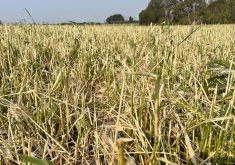Across Canada, the late-summer reports were a wild mixture of good, bad and ugly. Crops seemed stellar in southeastern Manitoba, yet in parts of Alberta and Saskatchewan, late rains couldn’t undo earlier drought damage, while in Ontario, the outlook swung from excellent to poor based on late frosts and excess rain.
In that context, Country Guide spoke with two farmers who were dealing with two very different weather situations. For Eldon Klippenstein in Manitoba, the year was shaping up to be bin busting. Conversely, in southern Alberta, Tony Varekamp was harvesting dryland winter wheat that was yielding about half of normal.
Read Also

The big squeeze: How to be fair to siblings during farm succession
Managing sibling business relationships on family farms.
Over the years, most of us have eaten from both sides of this plate, and although we can’t control the weather, we have learned to mitigate the risk. We buy crop insurance and we diversify production. We add irrigation, or tile drainage. And we market around the weather.
There is a next level of sophistication, however, whose objective is to take advantage of the opportunities that the weather creates. It’s a strategy that requires recognizing the volatility of weather markets, tracking forecasts, and seizing the opportunities that line those clouds.
With margins that are tighter these days, and with weather variability that seems to be increasing too, survivors know how to execute smart, disciplined marketing in tough weather situations and how to wring as much out of the system as they can, when they can.
Make hay when the sun shines
Brenda Tjaden Lepp, co-founder and chief analyst of FarmLink Marketing Solutions was driving from Winnipeg to Saskatoon in midsummer when Country Guide caught up to her. From her windshield, most crops looked great overall, although some fields had been damaged by the high winds and rain that had roared through the area, complete with an incredible three-hour tornado, the night before.
This year, Tjaden Lepp has suggested that her farm clients in this area stay with their marketing plan and avoid selling into the bearish harvest market. “If there’s no concerns about yield, we consider it safe to pre-sell 20 to 30 per cent of expected yields,” she said.
The tornado touched down about 175 miles from Eldon Klippenstein’s farm near Altona, Man., so his farm was unscathed. When he had assessed the crops for yield potential in mid-July, they looked very promising. His estimates put overall yields up at least 10 per cent above average.
With the ideal growing conditions, and knowing his cost of production, Klippenstein wanted to catch a price rally earlier in the summer and he had the confidence to pre-sell aggressively. “At this point, production risk is fairly low,” he said. “If the crop looks good and the production risk is fairly low, I’ll forward price a lot.”
“A lot” is a serious understatement. Overall, Klippenstein has about two-thirds of normal production pre-sold, and for the next third he has shorted the market on the board.

His confidence is built on a business plan of seeding a variety of crops, often for seed and via direct contracts set up the year before. He grows substantial acreages of soybeans and navy beans, plus CPS wheat and oats, with both cereals destined for milling.
This summer, a third of his wheat was under contract for seed production and 60 per cent of the remainder was already sold on a fixed-price, deferred-delivery contract.
A strong relationship with the buyer means he was able to market 100 per cent of the oat crop a year in advance. This relationship has been built up over years of working closely with the buyer and being up front with the production program. The pricing mechanism is set ahead through a written contract so each party remembers the details. He’s open with the buyer and tries to do things that make the buyer confident that the quality is consistently going to be there.
Both parties get what they need. Klippenstein gets a home for his crop, and the buyer knows they’re going to get all his production. “I don’t do anything that will jeopardize this relationship, and always give them a heads-up,” said Klippenstein. “This opens the door to do some out-of-the-box marketing.”
Basis and the dollar
Klippenstein hasn’t used any basis contracting this year. “I see the merits of basis contracting but I do very little with basis,” he said.
Frank Backx, grain marketer for Hensall District Coop in southwestern Ontario also avoids basis selling and instead is a 100 per cent, flat-price seller, aiming to sell in increments into strong prices. “If I do basis wrong and Chicago falls, I get hit with a double whammy,” he explained.
This summer, Ontario basis was significantly impacted by the falling loonie. “I’m bearish on the Canadian dollar,” said Backx. “With the election coming, the government wants to stimulate the economy and is trying to do that by lowering interest rates. By the new year, a $0.72 Canadian dollar wouldn’t surprise me.”
The drooping Canadian dollar was a boost across the country. “I was way upside down in my hedge account until the Canadian dollar started dropping,” said Klippenstein.
The currency drop has also helped his navy beans that are heavily sold, with one-third of the crop pre-booked. “I’ve been able to capitalize on the foreign exchange.”
His dry edible beans hadn’t flourished as much as the other crops with the abundant moisture. As of the end of July it looked like the wet low spots would reduce yields 10 per cent, but Klippenstein was hopeful that their aggressive fertility program for dry beans will help them pull through better in August.
On the other hand, his soybeans were impressive. Klippenstein already had 80 to 85 per cent of average yields sold, including for seed production and deferred delivery, and he also had call and put hedges on the Chicago and Minneapolis markets. “I’m being super aggressive this year and added to sales during the June/July rally.
“If there are profits to be had, sell into the rallies,” said Klippenstein.
Track and react
Klippenstein does follow the weather, however. Locally he looks at Accuweather, and on his own farm, operational decisions are helped by field stations that record and send data by email on wind and rain events. He also closely follows what’s happening in the U.S. Midwest by looking at the NOAA forecast and the five- to seven-day forecast.
Through the winter, when developing seeding and marketing plans for his soybeans, Klippenstein closely follows South American weather and he tracks seeding intentions in Brazil. “It tells me if I should be aggressive or patient in marketing the next year’s crops,”
Closer to home, he utilizes Twitter. Klippenstein has a network of farmers and buyers in Ontario he follows for insight on the navy bean crop there and in Michigan. Similarly, he follows farmers in the U.S. and Brazil for
soybeans.
Before he enters into a sale, he’ll sometimes converse with a FarmLink analyst to justify the move, using them as a sounding board and asking for additional research and to see if there’s anything he’s missed. “Farmers, traders and weather guys are my source,” he said.
In Ontario seeding was challenging with heavy rains and a late frost that nipped low-lying areas. “Luckily the corn was less than the fifth-leaf stage so it should recover and the beans were mostly still below the soil,” said Backx.
Then in June it rained and rained, and rained some more. While rain gauges overflowed and sprayers sat idle in Ontario, south of the border comparisons flew around with the 1993 great flood of the Mississippi River.
Reports of the eastern Grain Belt being flooded and drought in the western U.S. and Canada instigated some raging-bull activity on the markets. For five weeks starting in mid-June, there were some selling opportunities.
Backx said the other factor stimulating Chicago trading this spring was that the speculators were short on corn, soybeans and wheat. In four weeks, 340,000 corn contracts were bought — that’s 1.6 billion bushels, roughly the same amount as the USDA carry-out projected for this year. When they started buying, corn rallied $0.90.
There’s more volatility ahead before the crop comes off, predicted Backx. Farmers should try to track that volatility and take advantage, he said. “In wet years, crops tend to disappoint, I think that will happen again this year.”
Drought impact
Near Bow Island, an hour and a half east of Lethbridge, Tony Varekamp was driving between fields, organizing crews and machinery to harvest winter wheat. This year their five combines are driving a little farther to fill the buggies. “The winter wheat is only yielding 30 to 32 bushels on our dry land,” he said. “Normally I can count on 45 or 50 (bushels). Under irrigation it looks like it’s going to top 100 bushels an acre, maybe even 110.”
Varekamp had pre-contracted 2,000 tonnes of winter wheat which he thought he would meet and surpass because of the irrigated fields. He had booked about half of expected yields during the winter and sold some wheat into the summer rally.
The average price he got was $6.30 so he feels this was a conservative pricing strategy that he could easily get out of.
With less than an inch of rain this spring and summer, the difference between the crops grown under the pivots compared to dry land was stark. “Any rain in the forecast now isn’t going to help,” said Varekamp. “We needed it two months ago.”
On Varekamp Farms, canola was the worst hit by the drought and Varekamp estimated it will yield only 10 to 15 bushels an acre -on ground where a 50-bushel crop is normal. They also grow 16,000 acres of peas, canola, and four different types of dry edible beans, sugar beets, potatoes, and winter and spring wheat. Some 70 per cent of their land is under pivots; on the rest they dryland farm peas, wheat and canola.
Varekamp pre-booked 20 bushels per acre and was pretty sure they won’t meet that target. It’s a little more than he normally contracts but once again he liked the price and they should easily be able to buy to fill those contractual obligations.
Normally, Varekamp tends to direct sell in most months of the year. This year he was more aggressive and pre-booked solid prices in January, February and March, and then catching some of the spring/summer rally.
In early April the canola basis in Lethbridge skyrocketed. Although it levelled off by the summer, the November-December was still relatively strong and a definite opportunity.
For farmers who can hold off delivery until after harvest, there might be some opportunities on a basis contract or a fixed delivery contract, said David Lea, Market Place Commodities Ltd. in Lethbridge.
Some farmers get stuck in the watch-and-hold mode, waiting for prices to go higher without taking advantage along the way by capturing returns over their cost of production. Others will take it to an extreme, holding out for a peak that they rarely hit.
With commodities like barley, where there’s no future’s market to hedge, Lea suggested booking 25 per cent at the beginning of the year and if the crop’s decent, pre-selling up to half the crop. This way, many marketers lock in cost of production.
“There were many reluctant sellers in the recent up move in the market,” said Lea. “The good marketers are willing to sell in an up market.”
In two days, barley dropped from $250 to $220 a tonne, said Lea, but the guys who sold right before had watched the forecast and knew decent province-wide rains were coming.
The drought might also create some local selling opportunities. Although barley acres are up across the province, Lea was expecting the lower yields and quality to be impacted.
Varekamp’s brother farms in Holland and the two exchange weather information so he has first-hand information on what the crop has been like in Europe and he shares how the weather is in the Prairies and keeps a close eye on Kansas and Texas. He also watches what the weather trends are in Australia, knowing that usually half that country is burning up and the other half is drowning.
Disasters set the price, said Varekamp. He also keeps in mind the political disasters, like Russia’s invasion of Ukraine. “I watch the news, the TV, read Market Sense, talk to Cargill,” Varekamp said. But still it takes judgment, he said. “After reading all those reports and combining them, I get some sense of the trends and go with a gut feeling.”
















